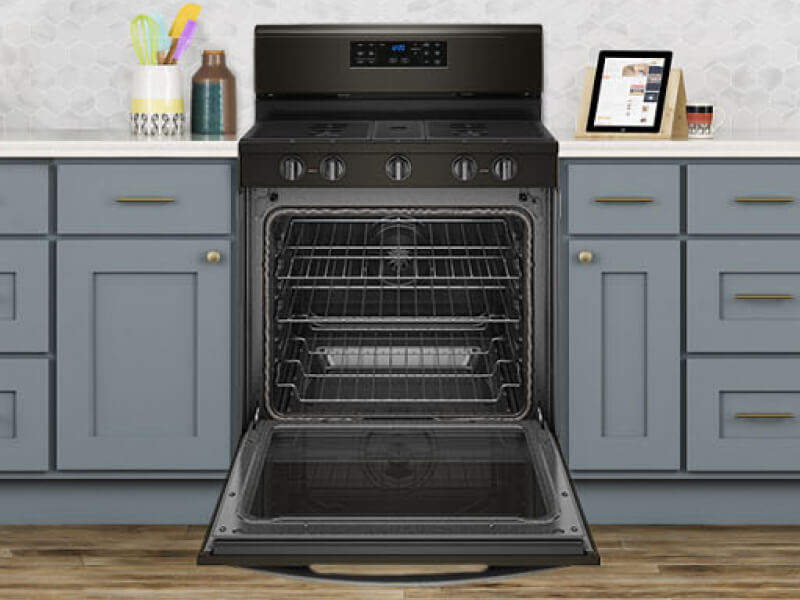
How to clean an oven
Having a nice-looking kitchen is only one reason why cleaning your oven is important. When you heat up a dirty oven, stuck-on food can result in unpleasant odors in your kitchen and undesirable flavors in your food.
Keeping your oven clean means less prep work when dinner time rolls around. Spend it at the table and not in the kitchen by ensuring your oven is clean and ready for your next dish. Follow these easy steps to clean your oven and make mealtimes with your family run as smooth as possible. In general, it's recommended to clean your oven every three to six months, or more often if spills and messes occur. Cleaning regularly can also prevent gas smells from your oven.


Instructions for thoroughly cleaning an oven
With a rag or dishcloth, you can clean your oven by wiping the interior and exterior of the appliance down using common household materials like baking soda, vinegar and lemon juice. To wash the racks, simply soak in soapy water before giving them a good scrub with a stiff bristled cleaning brush.
Select Whirlpool® ovens and ranges feature a self-cleaning cycle that can simplify this process. If your oven doesn’t have a self-cleaning cycle, or you simply prefer to clean it by hand, follow the steps below for an overview of how to keep your oven clean.
Tools
A stiff bristled cleaning brush
A rag or dishcloth
Soft cloth towels
A brush or flexible silicone spatula
A plastic scraper
A spray bottle
Supplies
Old towels
Dish soap or laundry detergent
Plastic trash bag (optional)
Baking soda
White vinegar
Lemon juice or vanilla (optional)
Oven-safe baking dish
Glass cleaner (optional)
Stainless steel cleaner (optional)


Step 1: Remove and clean oven racks
Just like the rest of your oven, your oven racks can collect grease and spills. Soaking and scrubbing them can help remove the grime.

Soak the oven racks
Remove the oven racks from your cooled oven and place them in a large sink. If your sink isn’t big enough to lay the racks flat, you can use your bathtub lined with old towels to prevent scratching. Fill with enough hot water to cover the racks, then pour in ½ cup of mild dish soap or ¾–1 cup of laundry detergent. Soak for at least two hours or overnight, depending on the dirtiness of the racks.

Scrub oven racks clean
Use a stiff bristled cleaning brush to scrub the racks, then use a rag or dishcloth to wipe them clean. Rinse your oven racks completely.

Dry and replace the oven racks
Use soft cloth towels to completely dry the racks and avoid rust or corrosion. Replace the racks unless you're also cleaning the oven interior.


Step 2: Clean the inside of the oven
Over time, food can build up on the walls of your oven, which is why it’s important to clean the inside of the oven frequently. Wiping the oven interior down with baking soda and vinegar or lemon juice can help you remove stubborn splatters and spills.

Prepare to clean the oven interior
Starting with a cool oven, remove all pots, baking sheets or other baking accessories, as well as your oven racks. Place towels or a plastic trash bag under your oven door to help catch drips.

Clean your oven with baking soda
Pour ½ cup baking soda into a bowl and add 3 tablespoons of water to create a thin, spreadable paste. Using a brush or flexible silicone spatula, spread the mix throughout the inside of the oven, coating the top, sides, bottom and door, including the door glass. Let rest anywhere from 20 minutes to overnight depending on the dirtiness of your oven.
To remove burnt food on the bottom of the oven, you can try using baking soda to help loosen the residue, making it easier to wipe spills and messes away. Get burnt residue off the bottom of your oven by mixing baking soda and water to form a paste. Then, use a nonscratch scrubbing sponge or plastic scraper to gently scrub the oven.
For tricky spots that are really tough to remove, you can apply a layer of the baking soda paste over the surface for 12 to 24 hours before wetting and scrubbing it off.

Wipe up the baking soda with vinegar or lemon juice
Spray the oven interior down with white vinegar or lemon juice and wipe everything with a damp rag or dishcloth. Use a plastic scraper to remove stubborn spots. Repeat this step until all of the baking soda paste is removed.

Clean the interior oven door glass
Spray the glass surface with white vinegar or lemon juice and wipe down with a damp cloth. Repeat this process until all of the baking soda paste is removed. Spray down one last time with vinegar or lemon juice, then dry with a soft cloth.
Oven Cleaning tip:
Looking for an easier way to clean your oven? Self-cleaning ovens can turn grease into a powder that you can wipe away. Shop self-cleaning ovens and ranges or learn more about how to run a self-cleaning oven cycle.


Step 3: Remove lingering oven odors
Cleaning the inside of your oven should help take care of most odors, but some pesky food smells like fish are harder to combat. Deodorize your oven with items commonly found in your household, like lemon juice, white vinegar or vanilla.

Prepare oven deodorizing solution
Preheat the oven on low heat. Fill an oven-safe baking dish with about an inch of water. Add either a teaspoon of lemon juice, white vinegar or vanilla, depending on your preference and what you have on hand.

Heat deodorizing solution in oven
Place the baking dish in the oven at a low temperature for about an hour, adding water if too much evaporates. Remove when the smell is neutralized and enjoy your refreshed oven.


Step 4: Clean the outside of the oven
Cleaning the outside of your oven the right way doesn’t just make things look cleaner—it can also help protect your oven’s finish. You can clean the outside of your oven by using a mild liquid cleaner or a dedicated solution like affresh® Stainless Steel Cleaning Spray.1

Clean exterior oven door glass
Close your oven door and spray the exterior of the window with vinegar or glass cleaner. Wipe with a soft cloth.

Clean the stovetop and exterior oven surfaces
For porcelain enamel surfaces or when cleaning glass electric stovetops, spray with a glass cleaner or mild liquid cleaner and scrub with a non-abrasive scrubbing pad. Gently clean around the model/serial/rating plate because scrubbing may remove numbers. To avoid surface staining on models with metallic paint, do not use abrasive cleaners, cleaners with bleach, rust removers, ammonia, or sodium hydroxide (lye). If the outside of your oven door is stainless steel, use a special stainless steel cleaner.
In addition to surfaces, be sure to also clean your gas stove burners and grates with a non-abrasive scrubbing pad or cloth and gentle cleaner or soap.
Care tip:
If you have a porcelain enamel exterior, make sure to clean up spills containing acids like vinegar and tomato as soon as the entire range is cool to avoid damaging the finish.
Shop Whirlpool® ovens
With helpful features like Adjustable Self-Cleaning Technology on select models, Whirlpool® ranges and ovens are designed to make mealtime more manageable so you can focus less on cleanup and more on spending time with your family. Keep your kitchen looking its best by browsing the full collection of ranges and wall ovens by Whirlpool brand to find the appliance that’s right for your home.
Need to clean your stovetop as well? Follow our guide for how to clean gas stove grates and burners or how to clean a glass cooktop to get all your cooking appliances sparkling.
Was this article helpful? Pass it on
Discover more from Whirlpool Brand


home heartbeat
Ready for more tips, home hacks and appliance guides?

